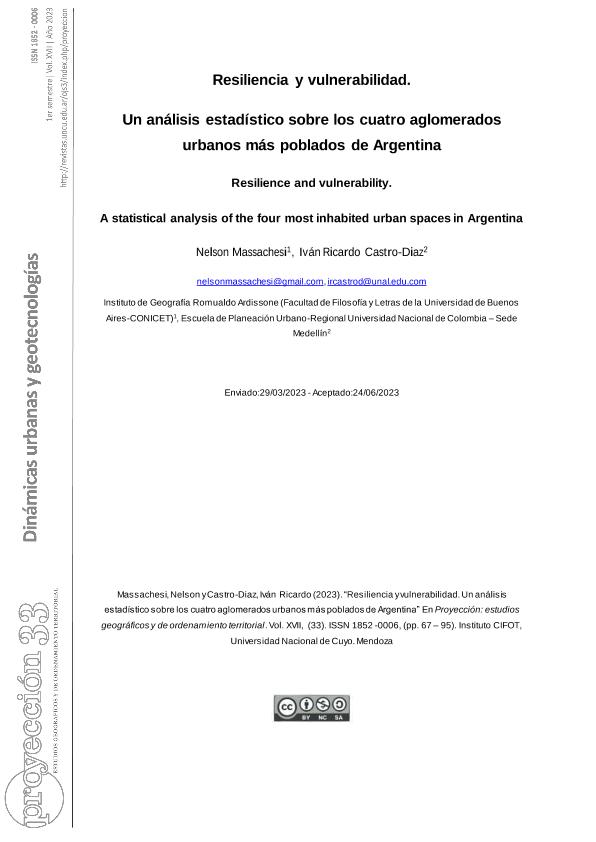Mostrar el registro sencillo del ítem
dc.contributor.author
Massachesi, Nelson Patricio

dc.contributor.author
Castro Diaz, Ivan Ricardo

dc.date.available
2023-12-20T14:55:35Z
dc.date.issued
2023-07
dc.identifier.citation
Massachesi, Nelson Patricio; Castro Diaz, Ivan Ricardo; Resiliencia y vulnerabilidad en un contexto pandémico: Un análisis estadístico sobre los cuatro aglomerados urbanos más poblados de Argentina; Universidad Nacional de Cuyo. Facultad de Filosofía y Letras. Instituto de Cartografía, Investigación y Formación para el Ordenamiento Territorial ; Proyección; 17; 33; 7-2023; 67-95
dc.identifier.issn
1852-0006
dc.identifier.uri
http://hdl.handle.net/11336/220943
dc.description.abstract
La resiliencia, entendida como la capacidad de un sistema para absorber impactos, se erige como una preocupación central en las áreas metropolitanas: instituciones nacionales y supranacionales desarrollan planes tendientes a tratarla a partir de la reducción de la vulnerabilidad. Por ello, este artículo focaliza en los cuatro aglomerados urbanos argentinos que superan el millón de habitantes: Gran Buenos Aires-Gran La Plata (AGBA-GLP), Gran Córdoba (AGC), Gran Rosario (AGR) y Gran Mendoza (AGM); el objetivo es diseñar una alternativa del índice de Vulnerabilidad Social ante el Desastre (IVSD) para calcularlo desde el primer trimestre de 2020 hasta el tercero del 2022 y así aproximarse a su resiliencia. Metodológicamente se acudió a los microdatos de la Encuesta Permanente de Hogares (EPH) del Instituto Nacional de Estadísticas y Censos (INDEC). Ante las tres dimensiones que componen al índice (social, habitacional y económica), la habitacional es la que presenta mayor heterogeneidad entre los cuatro espacios siendo que el acceso a agua de red y a servicio cloacal destacan al respecto. Finalmente, tras postular la hipótesis que la magnitud demográfica está asociada positivamente con el IVSD, no se encuentra correlación pero el resultado cambia drásticamente tras eliminar al AGBA-GLP (el de mayor tamaño) del cálculo.
dc.description.abstract
Resilience, understood as the capacity of a system to absorb shocks, stands as a central concern in metropolitan areas: national and supranational institutions develop plans to address it based on vulnerability reduction. Therefore, this article focuses on the four Argentine urban agglomerates that exceed one million inhabitants: Greater Buenos Aires-Gran La Plata (AGBA-GLP), Greater Córdoba (AGC), Greater Rosario (AGR) and Greater Mendoza (AGM); the objective is to design an alternative of Index of Social Vulnerability to Disaster (IVSD) to calculate it from the first quarter of 2020 to the third quarter of 2022 and thus approximate its resilience. Methodologically, little data (or small data) from the Permanent Household Survey (EPH) of the National Institute of Statistics and Censuses (INDEC) were used. Given the three dimensions that make up the index (social, housing and economic), housing is the one that presents the greatest heterogeneity among the four spaces, being that access to network water and sewage service stand out in this regard. Finally, after postulating the hypothesis that the demographic magnitude is positively associated to the ISVD no correlation is found, but the result changes drastically if the AGBA-GLP (the largest) is eliminated from the calculation.
dc.format
application/pdf
dc.language.iso
spa
dc.publisher
Universidad Nacional de Cuyo. Facultad de Filosofía y Letras. Instituto de Cartografía, Investigación y Formación para el Ordenamiento Territorial
dc.rights
info:eu-repo/semantics/openAccess
dc.rights.uri
https://creativecommons.org/licenses/by-nc-sa/2.5/ar/
dc.subject
áreas metropolitanas vulnerabilidad, resiliencia
dc.subject
vulnerabilidad
dc.subject
resiliencia
dc.subject.classification
Estudios Urbanos

dc.subject.classification
Geografía Económica y Social

dc.subject.classification
CIENCIAS SOCIALES

dc.title
Resiliencia y vulnerabilidad en un contexto pandémico: Un análisis estadístico sobre los cuatro aglomerados urbanos más poblados de Argentina
dc.title
Resilience and vulnerability: A statistical analysis of the four most inhabited urban spaces in Argentina
dc.type
info:eu-repo/semantics/article
dc.type
info:ar-repo/semantics/artículo
dc.type
info:eu-repo/semantics/publishedVersion
dc.date.updated
2023-12-20T10:32:03Z
dc.journal.volume
17
dc.journal.number
33
dc.journal.pagination
67-95
dc.journal.pais
Argentina

dc.description.fil
Fil: Massachesi, Nelson Patricio. Universidad de Buenos Aires. Facultad de Filosofía y Letras; Argentina. Consejo Nacional de Investigaciones Científicas y Técnicas; Argentina
dc.description.fil
Fil: Castro Diaz, Ivan Ricardo. Universidad Nacional de Colombia; Colombia. Consejo Nacional de Investigaciones Científicas y Técnicas; Argentina
dc.journal.title
Proyección
dc.relation.alternativeid
info:eu-repo/semantics/altIdentifier/url/https://revistas.uncu.edu.ar/ojs3/index.php/proyeccion/article/view/6714
dc.relation.alternativeid
info:eu-repo/semantics/altIdentifier/doi/https://doi.org/10.48162/rev.55.037
Archivos asociados
